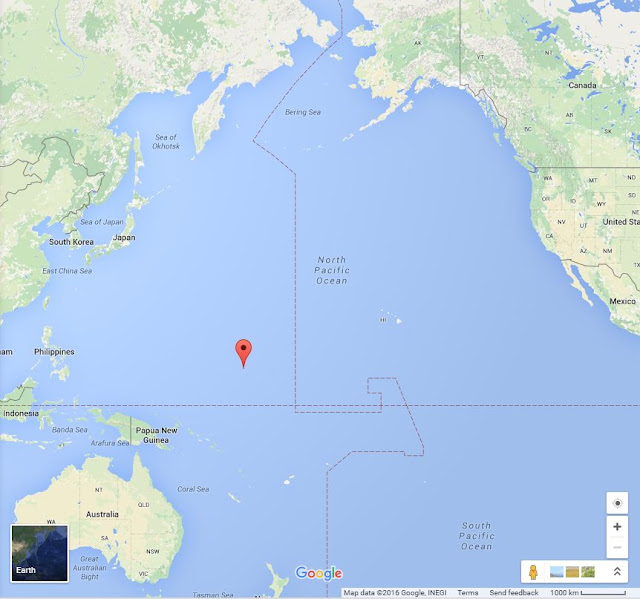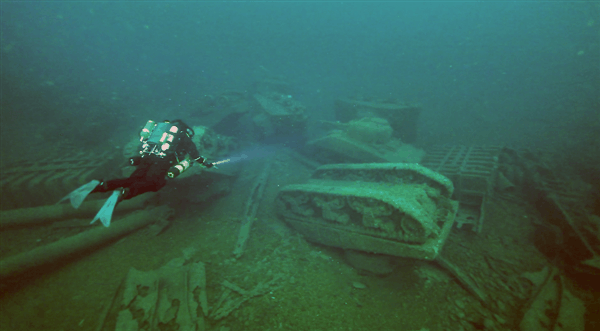 |
| Flight deck of the PBM-3D which crashed at Kwajalein on February 16, 1944
Kwajalein Atoll is part of the Republic of the Marshall Islands. The southernmost and largest island in the atoll is named Kwajalein Island.
Dan Farnham speaks to WW2 Wrecks and pierekosmidis.blogspot.com about the Kwajalein Missing in Action (MIA) Project:
"The Kwajalein MIA Project (KMP) is all-volunteer team which is made up of 28 members.
Of that number, 22 of us live here on Kwajalein full-time. Six members live in the continental United States, and fulfill such critical roles as research, public relations, and assisting with fundraising.
Of the 22 team members who live here at Kwajalein, 17 are divers.
The rest comprise research and archeology advisors.
We also have members on the team who are experts in aviation, unexploded ordnance (UXO), and side-scan sonar operations."
The Kwajalein Missing in Action (MIA) Project is dedicated to finding World War II aircraft lost in the Kwajalein Atoll lagoon between 1942-45.
The goal of the Kwajalein MIA Project is to locate and identify WWII aircraft wrecks within the Kwajalein Atoll lagoon for maritime heritage discovery, preservation and education.
The primary mission is to help facilitate the recovery of American MIA servicemen from WWII.
The project will include education with emphasis on Operation Flintlock.
Wreck sites are not disturbed in any way by the Kwajalein MIA Project team.
No pieces of wreckage will be removed, moved or sand sifted to attempt to ascertain whether human remains are contained in the wreck or nearby.
The dive team on this project is not trained or certified for recovery.
In late January 1944, a combined force of U.S. Marine and Army troops launched an amphibious assault on three islets in the Kwajalein Atoll, a ring-shaped coral formation in the Marshall Islands where the Japanese had established their outermost defensive perimeter in World War II.
Kwajalein Island and the nearby islets of Roi and Namur were the first of the Marshall Islands to be captured by U.S. troops, and would allow the Pacific Fleet to advance its planned assault on the islands and its drive towards the Philippines and the Japanese home islands.
|
On January 30, 1944, after a massive air and naval bombardment lasting some two months, a U.S. Marine and Army amphibious assault force of 85,000 men and some 300 warships) approached the Marshall Islands.
On February 1, the 7th Infantry (Army) Division landed on Kwajalein Island, while the 4th Marine Division landed on the twin islands of Roi and Namur, 45 miles to the north.
A single Marine regiment captured Roi on that first day, while Namur fell by noon of the second day.
The battle for Kwajalein would prove more difficult, as the 7th Infantry pounded the Japanese garrison there for three days until the island was declared secure on February 4.
Though greatly outnumbered from the start (by more than 40,000 on Kwajalein) the Japanese chose to fight until the bitter end.
Japanese casualties on Roi and Namur numbered more than 3,500 killed and around 200 captured, with less than 200 Marines killed and some 500 more wounded.
On Kwajalein, close to 5,000 Japanese defenders were killed and only a handful captured; the 7th Infantry counted 177 soldiers killed and 1,000 wounded.(SOURCE)
 |
| Wing section of the PBM-3D which crashed at Kwajalein on February 16, 1944 PHOTO: Dan Farnham/Kwajalein MIA Project (KMP) |
Here is what Dan Farnham has to say about the Kwajalein MIA Project:
What is your current status? Any specific wrecks you are looking for right now?
We are a very active group. Currently, we are looking for the following planes:
1) OS2N-1 ‘Kingfisher’, shot down on 31 Jan. 1944 with the loss of the pilot, LT Forney Fuqua.
2) SOC-3A ‘Seagull’, shot down on 1 Feb. 1944, with the loss of the pilot, ENS William Sayers and US Army artillery spotter CPT George Tyson.
3) PB2Y-3 ‘Coronado’, which crashed during landing on September 14, 1944 with the loss of Pharmacist’s Mate 1st Class Fred Matson.
The plane broke in half behind the wing during the crash.
Both halves of the plane floated on the surface of the lagoon for about half an hour before sinking.
The back half of the plane was found in August 2015, and another piece from the front half of the plane was found in July 2016.
Matson was in the forward bunking compartment at the time of the crash, and the remainder of the front half of the plane has not been found yet.
4) SBD-5 ‘Dauntless’, shot down on December 4, 1943 with the loss of the pilot LT William Fitch and rear-gunner ARM1c John Linson.
The plane had been taking part in a softening up attack on Kwajalein Atoll, prior to the invasion the following month.
5) SBD-5 ‘Dauntless’, which went down following a mid-air collision with two other SBD’s on 31 Jan. 1944.
The collision resulted in the deaths of four of the six aircrew involved. One of those killed was a rear-gunner, ARM2c Phillip Barton, and he was declared missing-in-action.
A U.S. Navy Martin PBM-5 Mariner in flight. U.S. Navy National Museum of Naval Aviation photo No. 2011.003.137.014
You've found several aircraft so far. Which story is the most striking and why?
We’ve found the following three planes so far:
1) F6F-3 ‘Hellcat’ fighter plane which crashed off Bigej Island on 1 Feb. 1944 after getting caught in the explosion of an ammunition dump on the island.
The pilot, ENS John Clem, went in with his plane. Divers from our team found that wreck in October 2011.
2) PB2Y-5R ‘Coronado’ which crashed while landing on February 12, 1945.
That crash resulted in one of the flight crew, LT Harold Bowman, and one of the passengers, LCDR Samuel Givens, being listed as missing-in-action.
The nose of this plane was found in 2011 and verified in October 2015. The rest of the plane had been salvaged and towed to Ebeye Island, where it was subsequently cut up and disposed of in the lagoon.
Only the front of the plane forward of the wings was not recovered at the time, and this was the piece that divers finally discovered in 2011.
3) PBM-3D ‘Mariner’ which crashed while landing on February 16, 1944 shortly after the conclusion of Operation Flintlock.
The crash resulted in one of the pilots, LT(j.g.) Wilburne Piercy, being listed as missing-in-action.
The wreck of this plane was found in 2009 by several former Kwajalein residents, one of whom is a member of our project.
I don’t personally feel that any one wreck is more striking than another. Each one has its own story of tragedy and loss of life.
And each one represents one or more servicemen who never made it home to their families. For the wrecks we’ve found, we’ve reported them to the Defense POW/MIA Accounting Agency (DPAA), in the hope that a properly-trained underwater team can be sent in to excavate the wrecks and possibly recover the remains of the missing crewmen, so they can finally go home to their families.
How important is it for you to bring closure to the families of the MIA?
I don’t think that “closure” is quite the right word.
How can family members, especially those who are old enough to have been alive at the time these men died, ever really have full closure on a loss like what they endured.
I prefer to describe it as “bringing answers” to the families.
When their loved one died, all the families received was a telegram that said something along the lines of “we regret to inform you that (insert name here) has been declared missing in action in the Pacific.”
They were rarely given any more details due to wartime secrecy, and they’ve had to go decades without knowing what really happened or where.
One of the really rewarding aspects of our project is when we get to provide the families copies of the WWII action reports and deck logs that we find in the course of our research.
Because that gives them answers as to what exactly happened and where, which is information they haven’t had before.
Why Kwajalein? Why did you choose this specific Pacific area?
Kwajalein was a natural choice for us, as most of us already live here.
Those of us on the team who are divers are already history buffs, so took our love of wreck diving and history, and focused it towards the search for plane wrecks that are believed to contain missing-in-action servicemen.
 |
| LT William Fitch aboard the USS Lexington in early 1943. Fitch died in the crash of his SBD-5 Dauntless at Kwajalein Atoll on December 4, 1943. Photo courtesy of the Fitch family. |
 |
Tail section of the PB3Y-3
‘Coronado’ which crashed at Kwajalein on September 14, 1944.
The front half of
the plane, believed to contain the remains of PhM1c Fred Matson, has not yet
been found.
|
And since we live here already, we don’t have the overhead costs of things like lodging and air travel, therefore over 90% of the funds we raise for this go directly into search operations.
Further reading and resources
Website
Facebook page






























